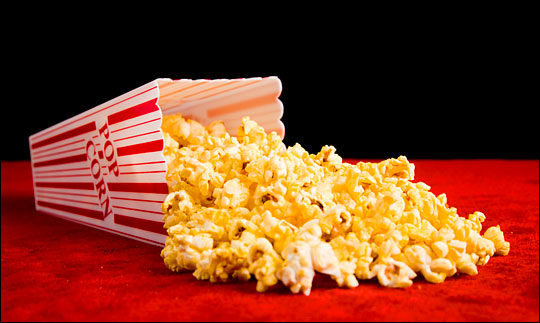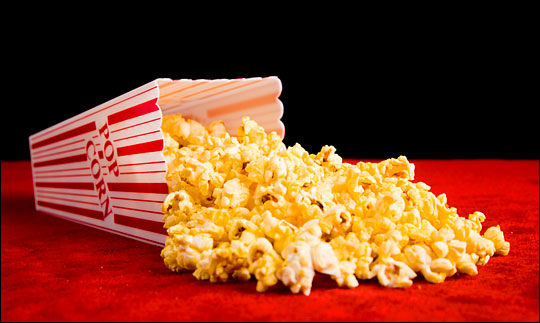In Checkout Line, Lou Bendrick cooks up answers to reader questions about how to green their food choices and other diet-related quandaries. Lettuce know what food worries keep you up at night.
—–
Dear Lou,
What about popcorn? Is it safe, healthy, and free of pesticides? What exactly is in the artificial butter flavor?
Thanks,
Greenee Trailer Trash from Mississippi

Dear Greenee,
You might be sorry you asked. When I’m done here, there won’t be much left to enjoy in your average batch of conventionally-grown and processed popcorn. But don’t give up hope. You know how, in basic training, the Army breaks people down and builds them back up again? I break down America’s favorite foods — in this case, one that we consume to the tune of 16 billion quarts each year — and build them back up with something more sustainable, and often more delicious.
In that vein, let’s take a look at the problems with your average store-bought popcorn. Now, Greenee, I’m going to use some harsh words, and I hope I don’t offend you. But I’m poppin’ mad about the state of popcorn — a fun-to-eat, whole-grain crunchy treat that has been deflated by the embrace of corporate food marketers.
The problems with conventional popcorn start in in the corn field.
The popcorn you find at the movie theater and in microwave boxes is likely to have been raised with the aid of insecticides, herbicides and fungicides, and fumigants.
For a less-than-soothing bedtime read on this delightful subject, download the Popcorn Agri Chemical Handbook. This chemo-phobe’s horror story includes a section on “tolerances” — that is, details on just how much pesticide the EPA will accept in your movie-time snack. If you don’t have time to curl up with this PDF, let me cut to the chase: The list of acceptable chemical residues is long and includes malathion, a nasty organophosphate.
Now, onto bad news masquerading as good news: According to the Popcorn Board, a nonprofit, check-off organization funded by U.S. popcorn processors, there is no genetically modified popcorn on the market — but, biotech varieties are in the works. How long popcorn will stay genetically pure is anyone’s guess, but it may be a moot speculation.
Many farmers now believe that, on account of corn pollen’s pesky habit of drifting around on the winds and fertilizing any old corn plant it meets, there is no genetically pure corn left in the world. Recently I was disturbed to read that my favorite garden seed suppliers, Baker Creek Heirloom Seeds, reported that they had been doing “major and expensive” GMO testing on all of their corn varieties. Sadly, much, if not most, of their corn is contaminated with GM Franken-genes.
GM corn is a big bummer because a recent study found that the mice that ate GM corn had impaired fertility, which grew worse with each subsequent litter. This bummer snowballs when you realize that most corn in the U.S. in now genetically modified.
Greenee, if you still can bear to eat corn at all, let’s also take a look at:
Artificial butter — that pathetic excuse for flavor
You know the fake but yummy buttery smell that wafts out of microwave popcorn bags? Until very recently, it was due to a flavoring agent, diacetyl, which causes the serious, potentially deadly, and ignobly-nicknamed disease popcorn lung, that has sickened factory workers who inhaled the stuff.
After popcorn lung sickened a consumer — a Colorado man who ate a whole lot of microwave popcorn — many big popcorn makers pulled it from their products.
Despite pressure from lung doctors, public interest groups, citizens, unions, politicians, and so forth, the FDA still classifies diacetyl, as “Generally Recognized as Safe” (GRAS). California, meanwhile, is trying to ban it. (For the latest developments on diacetyl, go the public health blog The Pump Handle.)
The Popcorn Board could not tell me whether any popcorn makers still used diacetyl. In an email, a spokesperson explained, “The mission of The Popcorn Board is to educate consumers about the fun, economical, whole grain nature of popcorn.” (And evidently to publish the Agri Chemical Handbook.)
I’m not sure what popcorn makers now use for butter flavor. According to Stephanie Childs, spokesperson for ConAgra Foods, their butter flavoring is a proprietary recipe that contains “no added diacetyl.” (Among ConAgra’s popcorn-centric brands are Orville Redenbacher’s, Jiffy Pop, Act II, FiddleFaddle, Poppycock, and Crunch N’ Munch.)
Are you still here Greenee, or have you clicked away and started drinking? (Remember, bourbon is made of corn. I’m just saying.)
Finally, let’s look at:
Excessive packaging — the handmaiden of Satan
Even though you can get store-bought popcorn with relatively clean ingredients (such as Newman’s Own Microwave Popcorn No Salt Organic), you are going to end up with some sort of bag at best, and at worst the Russian nesting doll-style of packaging that comes with microwave popcorn: a bag wrapped in plastic within a box. All of this packaging is hard on the earth, and some of it might be hard on your health.
The Teflon that coats some microwave popcorn bags can break down into a chemical that has been linked to cancer and birth defects in animals. Microwave popcorn bags are often coated with a perfluorinated chemical (PFC) called a “fluorotelomer” that can break down into perfluorooctanoic acid (PFOA), which can make its way into hot food such as piping hot popcorn.
Not surprising, California (new state motto: “the Cassandra State”) attempted to pass a bill to remove PFCs from food packaging. ConAgra, by the way, is phasing out its microwave popcorn bags that contain PFOAs.
Don’t go away yet, because, as promised, I need to build popcorn back up. There is, in fact, a way to eat your popcorn and not screw the planet or your health. Here you go:
Recipe for morale-building popcorn
Special equipment note: You will need a plain brown paper lunch bag.
Ingredients:
1/4 cup certified organic popcorn. This will be free of pesticides and free of Franken-genes (fingers crossed). If you are able, buy it in bulk to save money and reduce the packaging (bulk organic popcorn is typically available in natural foods markets). Or, look for kernels sold in recyclable glass jars.
Real butter, organic if possible. Sure, butter is high in saturated fat. But, like the nutritionist and educator Joan Gussow, has said, “I prefer butter to margarine, because I trust cows more than chemists.”
Instructions:
Although you may use any popcorn popping method you like, ironically, it’s the microwave that makes easy, fast popcorn without extra oil or closet-clogging equipment.
Put the corn in the lunch bag, fold it few times and put it in the microwave, fold side down. Nuke it for 2-3 minutes or until you hear the kernels slow down to about five seconds between pops. (Th
ere are those folks, including the Popcorn Board, who say that making popcorn in brown bags is dangerous and that you should stick to manufacturer’s packaging, but I, rebel that I am, choose to keep an eye on my cheap, cancer-free brown bag.)
Remove and open the bag very carefully, because the escaping steam will be hot (as, well, most steam is, whether it’s escaping or just doing time and waiting for parole). Dump the popped corn into a bowl and drizzle it with real butter.
Next, grab a movie. Watch the very smart and funny documentary King Corn if you are in the mood for yet more on the subject of corn and its industrial undoing. If not, I highly recommend any of those Jason Bourne movies.
So, dear Greenee, whether popcorn is safe, healthy, and free of pesticides depends on the kind you buy. Even if the flavorings in processed popcorn aren’t lung-searing, your average bag may contain lots of salts, artificial colors, flavors, trans fats, etc. If you can, make popcorn at home. Just don’t burn it — that smell will last all night and haunt your dreams.
Enjoy!
Lou
P.S.: I love your state. Not only is it fun to spell, but I had some of the best biscuits with molasses I ever had in my life in Mississippi. Please don’t ask me about biscuits or molasses. I can’t bear to break those down just yet.


